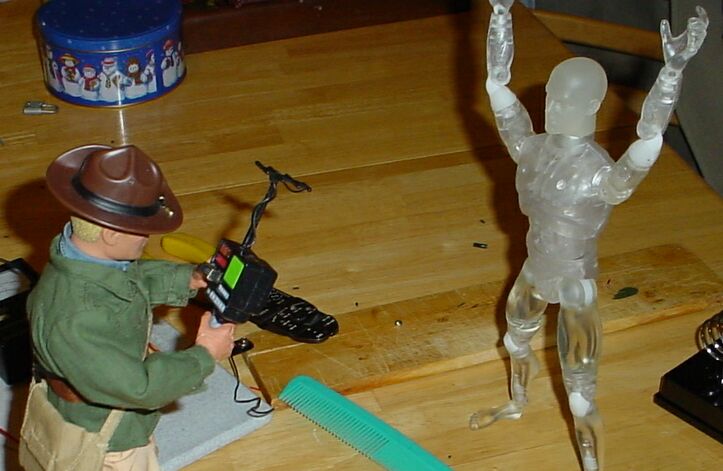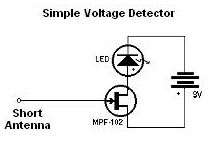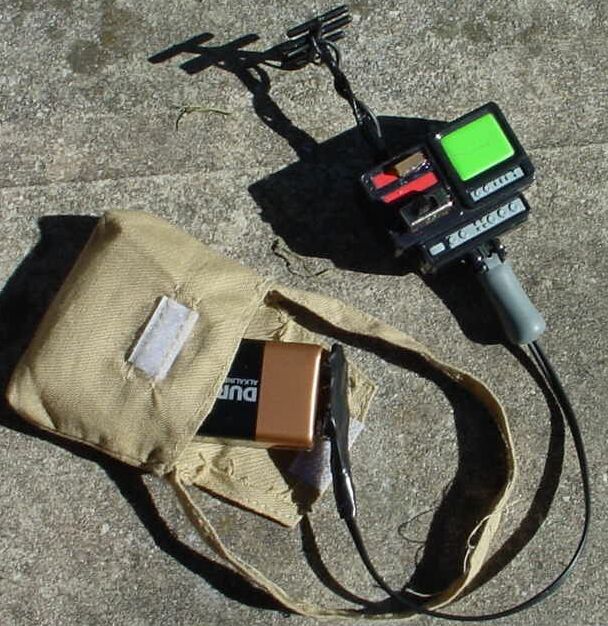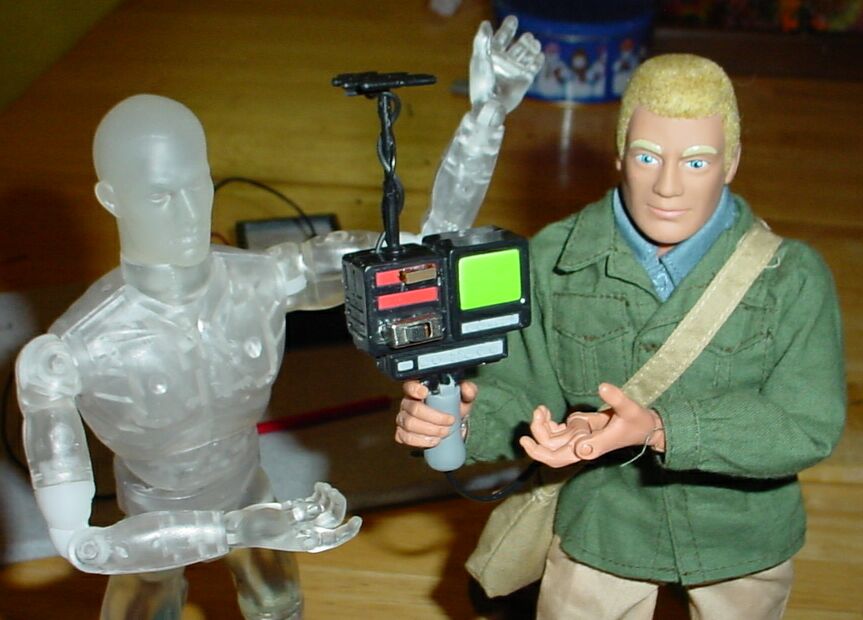Ever since the transparent Joes came to town, the balance of power
has been irreparably damaged. Just when one side begins to
achieve a victory, an invisible force runs around and subdues the Joe
team on the brink of their victory. What can be done to halt this
unseen menace? Fortunately for the Joe team, one of the
scientists deep in the laboratories of the Adventure Team Headquarters
developed an Invisible Joe Detector. It can detect - and almost
pinpoint - the location of the invisible Joe from up to 12 scale feet
away!

THE ELECTROSCOPE
An electroscope can detect the invisible fields of
voltage which surround all electrified objects. This little
circuit acts as a primitive electroscope with lots of fun
applications!
On a low-humidity day and with a short antenna wire, this little
circuit will respond strongly when someone combs their hair
nearby! If a metal object is lifted up on a non-conductive
support and touched to the sensor wire, the sensor can detect whether
that object supports an electrostatic potential of as little as one
volt! Real-world objects become "electrified" when their
pre-existing + and - charges are not equal. By the way, it won't detect
Invisible Joe unless he's got a static charge from a berber carpet,
wool sock, or something similar. It's the static that makes the LED
light up (or darken, depending on the polarity of the charge).
CONSTRUCTION HINTS
Below is the circuit. Don't connect the battery until you are SURE
you've hooked everything up exactly right. It's possible to burn out
the FET or the LED if they are connected incorrectly. Don't let the
transistor's wires bump together even briefly, or it will flash the LED
and burn it out. Don't ever connect any LED directly to a 9-volt
battery, it will burn out the LED.

A bare LED needs a 1000-ohm resistor wired in series to limit the
maximum current from the 9-volt battery. Avoid touching the Gate
wire of the FET. Small sparks jumping from your finger to the Gate wire
can damage the transistor internally. You might also want to add
a 1-meg resistor between the gate of the FET and the antenna, to help
prevent the FET from being harmed by accidental sparks to its Gate
lead. To test the circuit, charge up a pen or comb on your hair,
then wave it close to the little "antenna" wire. The LED should
go dark. When you remove the electrified pen or comb, the LED
should light up again.
SENSE E-FIELDS
Connect the circuit to its battery, and the LED will turn on. Comb your
hair, then hold the comb near the Field Effect Transistor (FET) gate
wire. The LED will go dark. This indicates that the comb has an excess
of negative charge, and the FET responds to the electrostatic field
surrounding the comb. It acts as a switch and turns off. Remove the
comb and the LED brightens again. Wiggle the comb, and find at how
great a distance the circuit still detects it. It's amazing how far an
e-field extends around an electrified object.
This FET sensor is not an ideal educational device because it responds
differently to positive than to negative Potential Difference at it's
"Gate" wire.
Rules for this FET:
* negative objects turn the LED off, it lights again
when removed.
* positive objects make the LED bright, then dark
when removed.
If you've been playing with it and can't get the LED to come back on,
then simply touching your fingers to the "Gate" wire and to some other
part of the circuit simultaneously and it will "reset." Or, touch
a plastic pen to some hair, then wave it near the sensor, and the LED
will light up.
In situations where the sensor is TOO sensitive, add a small capacitor
(with a value below 100 pf) between the FET gate lead and one of the
other leads. This reduces the sensitivity of the device - and can a big
difference. Capacitors larger than 100pF can be used, but they REALLY
wipe out the sensitivity.
Obtain a clip-lead, and connect it to the Gate lead of the FET. Let it
hang loose without touching anything. You'll find that this has vastly
increased the sensitivity of your FET circuit. On a dry day it will
respond to hair-combing from 20ft away.

DIPOLE ANTENNA
If you hold the unit in your hand and watch the LED, you'll see that
the Gate acts as the antenna, and negative objects make the LED go
dark. But if you hold the whole thing up in the air, but hold an
negatively electrified object near the battery, the LED will get
brighter - not dimmer; polarity of operation has been reversed. The FET
gate wire responds with one polarity, while the battery and the rest of
the circuit responds with the other.
(Originally an article entitled
"RIDICULOUSLY SENSITIVE CHARGE DETECTOR" (C)1987 William J.
Beaty: I edited this info for this project. Check out the
original website for more information at
http://www.amasci.com/emotor/chargdet.html)
Click here to return to the AT Commander's home page




